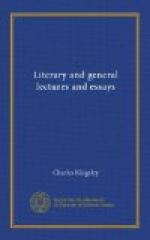Going forward to the age of the Reformation, the book then gives us a spirited glimpse of John Bokelson and the Munster Anabaptists, of Carlstadt and the Zurichian prophets, and then dwells at some length on the attempt of that day to combine physical and spiritual science in occult philosophy. We have enough to make us wish to hear more of Cornelius Agrippa, Paracelsus, and Behmen, with their alchemy, “true magic,” doctrines of sympathies, {309} signatures of things, Cabbala, and Gamahea, and the rest of that (now fallen) inverted pyramid of pseudo-science. His estimate of Behmen and his writings, we may observe in passing, is both sound and charitable, and speaks as much for Mr. Vaughan’s heart as for his head. Then we have a little about the Rosicrucians and the Comte de Gabalis, and the theory of the Rabbis, from whom the Rosicrucians borrowed so much, all told in the same lively manner, all utterly new to ninety-nine readers out of a hundred, all indicating, we are bound to say, a much more extensive reading than appears on the page itself.
From these he passes to the Mysticism of the counter-Reformation, especially to the two great Spanish mystics, St. Theresa and St. John of the Cross. Here again he is new and interesting; but we must regret that he has not been as merciful to Theresa as he has to poor little John.
He then devotes some eighty pages—and very well employed they are— in detailing the strange and sad story of Madame Guyon and the “Quietist” movement at Louis Quatorze’s Court. Much of this he has taken, with all due acknowledgment, from Upham; but he has told the story most pleasantly, in his own way, and these pages will give a better notion of Fenelon, and of the “Eagle” (for eagle read vulture) “of Meaux,” old Bossuet, than they are likely to find elsewhere in the same compass.
Following chronological order as nearly as he can, he next passes to George Fox and the early Quakers, introducing a curious—and in our own case quite novel—little episode concerning “The History of Hai Ebn Yokhdan,” a medieval Arabian romance, which old Barclay seems to have got hold of and pressed into the service of his sect, taking it for literal truth.
The twelfth book is devoted to Swedenborg, and a very valuable little sketch it is, and one which goes far to clear up the moral character, and the reputation for sanity also, of that much-calumniated philosopher, whom the world knows only as a dreaming false prophet, forgetting that even if he was that, he was also a sound and severe scientific labourer, to whom our modern physical science is most deeply indebted.
This is a short sketch of the contents of a book which is a really valuable addition to English literature, and which is as interesting as it is instructive. But Mr. Vaughan must forgive us if we tell him frankly that he has not exhausted the subject; that he has hardly defined Mysticism at all—at least, has defined it by its outward results, and that without classifying them; and that he has not grasped the central idea of the subject. There were more things in these same mystics than are dreamt of in his philosophy; and he has missed seeing them, because he has put himself rather in the attitude of a judge than of an inquirer.




